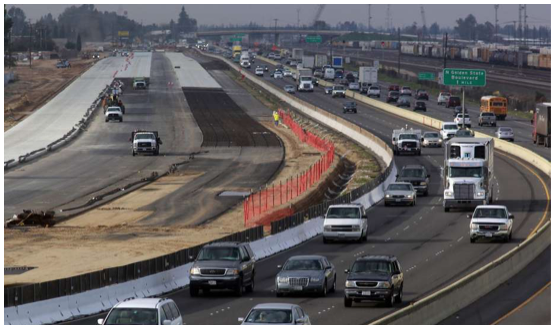CommentsINFLATED EXPECTATIONS-It will soon be nine years since high-speed rail was passed in California. But Californians haven’t gotten the high-speed rail system they were promised. Instead, high-speed rail has taken a new form: something more expensive and smaller in scope that will substantially increase traffic congestion in urban areas.
High-speed rail will cost Californians billions of dollars and in urban areas, increased traffic may cost Californians billions more. The project’s business plan relies on unrealistic ridership projections. It’s devoid of private funding because businesses see high-speed rail as likely to run at a loss. While high-speed rail wastes more taxpayer dollars, the private sector will make it obsolete with technological innovation and this will reduce future income from the high-speed rail system. High-speed rail authorities have violated federal law by making significant changes to the proposition approved by voters, who have yet to see the success they imagined when the bill passed.
When voters approved Proposition 1A with 52.7%, the estimated cost for high-speed rail going from Sacramento and San Francisco to San Diego was $45 billion. However, a 2011 business plan by the California High-Speed Rail Authority projected costs to be $98.5 billion, and potentially as high as $118 billion, while also ending at Anaheim rather than San Diego. Despite the enormous difference in cost, Californians were not consulted about whether they were still interested in high-speed rail. Instead, the project was scaled down, with slower speeds and fewer new tracks, estimated to cost $68.4 billion, and later $64 billion.
However, even the $64 billion figure, 42.2% higher than what voters approved, has proved unrealistic. High-speed rail has consistently been behind schedule and over budget. Figures show that the eventual cost may exceed $100 billion. World Bank numbers reveal high-speed rail in California is projected to cost $56 million per kilometer, the highest cost in the world.
To reduce projected costs, the state embraced a so-called blended system, where high-speed rail trains share tracks with local commuter systems at the northern and southern ends of the line. After an alteration to the high-speed rail business plan, the first phase of construction will connect the Bay Area with the Central Valley. The new plan will not meet the 2-hour 40-minute maximum travel time required by Proposition 1A. The blended system also violates Proposition 1A’s mandate that trains be fully independent and not shared.
In the densely populated Peninsula, the introduction of high-speed rail under the blended system will cause massive time increases. During the peak hour, trains will pass through every three minutes. New perimeter fencing and four-quadrant gates have officials concerned about increased congestion in the 41 places where train tracks meet the streets. According to a report by rail transportation expert Paul Jones, the number of vehicles that can cross the rail grade in gate up periods between trains during the peak will decrease by 60%. During peak hours, gate down times will approximately double. The cost of Bay Area traffic congestion is already $2.6 billion a year. New delays could mean millions or billions more in lost productivity.
The top speed for high-speed rail within the blended system will be 110 miles per hour. This means the California High Speed Rail Authority can avoid using grade separation (tracks going either under or over streets) on the Peninsula, which federal authorities require at speeds over 125 miles per hour. At 110 miles per hour, safety becomes an issue given the amount of gate crossings on the Peninsula. The local commuter system, Caltrain, already averages 12 fatalities a year since 1992, and has had nearly quadruple the fatalities of nearby BART, which is more extensive. In the absence of grade separation, increased speeds could jeopardize more lives.
What is this all for? In the Bay Area, the time benefits high-speed rail provides are minimal. The top speed for Caltrain between San Francisco and San Jose is 79 miles per hour. Currently, a bullet train goes from San Francisco to San Jose in 57 minutes. A high-speed rail “super express train” will go from San Francisco to San Jose in 47 to 49 minutes.
A 2012 Caltrain study found that for a workable schedule, local commuter service and high-speed rail must go at the same speed on the same tracks. High-speed rail can only go top speed on bypass tracks. During peak hour, high-speed rail must go the same speed as local commuter service. Such limitations defeat the purpose of a high-speed rail system.
It is no surprise that local citizens and government officials have been almost unanimous in their opposition to high-speed rail. When compared to the increased traffic burdens, high-speed rail looks to have a net negative effect on the Bay Area.
California does not have money to waste on high-speed rail. Our January 2017 study found that California has $1.3 trillion in state and local debt, including between $713 billion and $1.02 trillion in unfunded pension obligations. Given the high cost, poor execution, and questionable need, there is no reason to turn to high-speed rail to improve infrastructure. It is time to end the high-speed rail project before any more taxpayer money is wasted.
(David Schwartzman is a Policy Research Fellow at the California Policy Center. He is a rising senior studying economics, mathematics, and finance at Hillsdale College.) Edited for CityWatch by Linda Abrams.
-cw
















